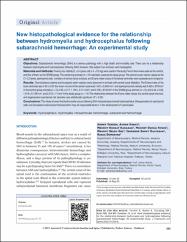New histopathological evidence for the relationship between hydromyelia and hydrocephalus following subarachnoid hemorrhage: An experimental study

Göster/
Erişim
info:eu-repo/semantics/openAccessTarih
2023Yazar
Yardım, AhmetKanat, Ayhan
Karadağ, Mehmet Kürşat
Aydın, Mehmet Dumlu
Gel, Mehmet Selim
Daltaban, İskender Samet
Demirtaş, Rabia
Üst veri
Tüm öğe kaydını gösterKünye
Yardim, A., Kanat, A., Karadag, M. K., Aydin, M. D., Gel, M. S., Daltaban, I. S., & Demirtas, R. (2023). New histopathological evidence for the relationship between hydromyelia and hydrocephalus following subarachnoid hemorrhage: An experimental study. Journal of craniovertebral junction & spine, 14(3), 253–258. https://doi.org/10.4103/jcvjs.jcvjs_67_23Özet
Objectives: Subarachnoid hemorrhage (SAH) is a serious pathology with a high death and morbidity rate. There can be a relationship
between hydromyelia and hydrocephalus following SAH; however, this subject has not been well investigated.
Materials and Methods: Twenty‑four rabbits (3 ± 0.4 years old; 4.4 ± 0.5 kg) were used in this study. Five of them were used as the control,
and five of them as the SHAM group. The remaining animals (n = 14) had been used as the study group. The central canal volume values at the
C1‑C2 levels, ependymal cells, numbers of central canal surfaces, and Evans index values of the lateral ventricles were assessed and compared.
Results: Choroid plexus edema and increased water vesicles were observed in animals with central canal dilatation. The Evans index of the
brain ventricles was 0.33 ± 0.05, the mean volume of the central canal was 1.431 ± 0.043 mm3
, and ependymal cells density was 5.420 ± 879/mm2
in the control group animals (n = 5); 0.35 ± 0.17, 1.190 ± 0.114 mm3
, and 4.135 ± 612/mm2
in the SHAM group animals (n = 5); and 0.44 ± 0.68,
1.814 ± 0.139 mm3
, and 2.512 ± 11/mm2
in the study group (n = 14). The relationship between the Evans index values, the central canal volumes,
and degenerated ependymal cell densities was statistically significant (P < 0.05).
Conclusions: This study showed that hydromyelia occurs following SAH‑induced experimental hydrocephalus. Desquamation of ependymal
cells and increased cerebrospinal fluid secretion may be responsible factors in the development of hydromyelia.

















